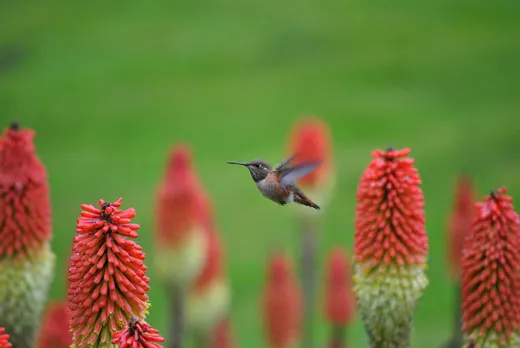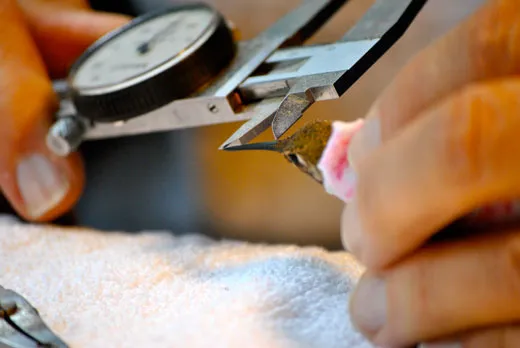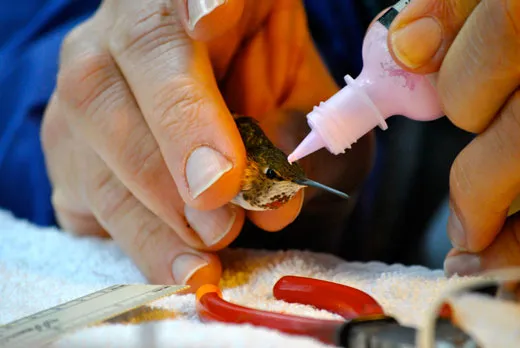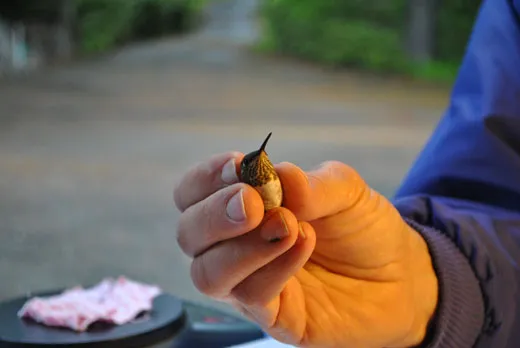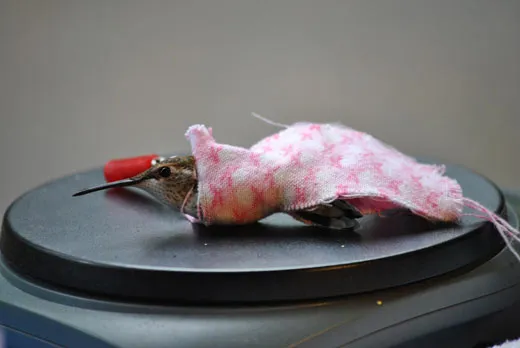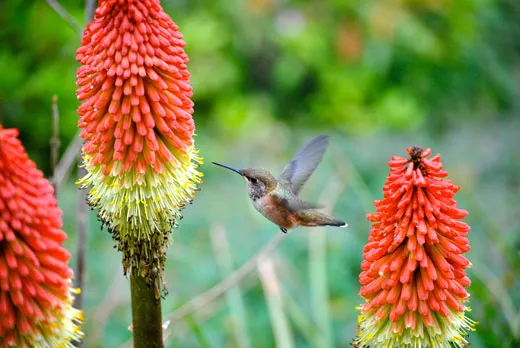Hummingbirds Are Popping Up in the Strangest Places
Two master bird banders are at the forefront of finding out why the rufous hummingbird’s migration has changed
/https://tf-cmsv2-smithsonianmag-media.s3.amazonaws.com/filer/Hummingbird-Banding-Wild-631.jpg)
It is a little past 6:30 in the morning on Whidbey Island, in Washington’s Puget Sound, and despite the earliness of the hour and wretchedness of the weather, Dan Harville is admiring the torch lilies in Al Lunemann’s garden. Hummingbirds flurry about the tall red plants, drinking, hovering and chasing each other.
“Okay,” Harville says, shaking himself from his reverie. “Let’s set up the trap.” He arranges a homemade, remote-controlled net over one of the feeders Lunemann keeps on the front porch. He waits until three or four hummingbirds are working the feeder’s spigots and then, with a push of a button, drops the net, trapping the birds inside. They flutter against the fine mesh, mildly befuddled. “Now,” Harville says, “you can just stick your hand in and get them.” Which he does, plucking them out one by one and placing each in its own small cloth bag so it will stay calm.
In Lunemann’s garage, Harville withdraws a small tuft of feathers—a female rufous hummingbird. He works quickly. “I only want to keep her for two minutes at most,” he says. He swaddles the bird in a scrap of fabric, clips it closed so she can’t fly away, and weighs her—“3.17 grams,” he tells his wife, Jan, who records the data. He measures the length of the bird’s needle bill, wing and tail feathers. He blows in the bird’s chest to measure her subcutaneous fat and determine whether she is plump and healthy. Then he picks up a speck of aluminum—the band—and deftly fits it around the bird’s tiny leg, tightening it ever so carefully with a pair of pliers. He dabs a dot of pink paint on the top of the hummingbird’s head so he will know she has already been processed should he catch her again. Finished, he holds her out in the palm of his hand. “Off you go,” he says. The hummingbird, which has until now been still and passive, zips away. Harville watches for a moment, and then reaches for the next twitching bag.
Harville, recently retired as a computer programmer at the University of Washington, is one of fewer than 100 master hummingbird banders in the United States. In 12 years of banding, he has caught 9,986 hummingbirds from five species (plus one hybrid); over the course of a single year, he will rotate his trap among six or seven sites throughout Washington. His aim is to help sketch migratory patterns, which are for the most part only vaguely known. But he hopes to help answer a larger question. In the last 20 years, rufous hummingbirds, along with some other species, have started to show up more and more in places they are not supposed to be. No one knows why, but Harville and his ilk would like to find out.
***
There are more than 320 species of hummingbirds, all restricted to the Western Hemisphere, and most found only in Central or South America. The rufous is one of 8 species that reliably breeds more than a few miles north of Mexico. It is a creature of extremes. Even though it is only three inches long and weighs an eighth of an ounce, it has the widest range of any hummingbird, spending the winter as far south as southern Mexico and breeding as far north as southeast Alaska. Some will migrate as much as 4,000 miles between their breeding and non-breeding grounds; in terms of body-length, the migration is the longest of any bird.
For much of the past century, central hummingbird dogma had it that, save for the ruby-throated, U.S. hummingbirds like the rufous were restricted to the western states in the summer; in autumn, to a bird, they all headed south of the border. “Any hummingbird seen in the U.S. in winter was a vagrant that was lost and was going to die,” says James Remsen, a biologist at Louisiana State University who studies hummingbirds. But the rufous hummingbird has of late shown a tendency to wander. One of Harville’s birds even spent the winter in Louisiana a couple of years ago. “A bander and I actually exchanged birds,” he says. “She caught one of mine, and I caught one of hers.”
The person who recaptured Harville’s bird was Nancy Newfield. Newfield is something a celebrity in the small world of hummingbird banders. In the late 1970s, she had started to see rufous hummingbirds in the winter around her Louisiana home. Not at every feeder, mind you, but regularly enough that she suspected something might be afoot. At the time, rufous hummingbirds were assumed to be rare in the Southeast. The first was seen in Louisiana in 1932; a second was seen three years later, in 1935. Sightings in the years following were intermittent, and between 1900 and 1990, fewer than 30 were seen per year. While the odd rufous was exciting for local birders, it was not thought indicative of any particular trend.
Newfield is not a scientist by training, so she went to a distinguished ornithologist at Louisiana State University and suggested that something interesting was going on that might be worth looking at more closely. In addition to the rufous, she had seen other western species—black-chinned hummingbirds, buff-bellied hummingbirds, broad-tailed hummingbirds, Allen’s hummingbirds—that were supposed to winter in Mexico and Central America, not Louisiana. The ornithologist told her, diplomatically of course, that most people who worked on birds wanted to go to South America to search for new species, not spend their winters poking around the yards and gardens of residential neighborhoods.
Newfield decided to investigate the phenomenon herself. She learned about hummingbird taxonomy, anatomy and physiology. She got a federal bird-banding permit in 1979 and started to capture wintering hummingbirds. Her first year, she banded 10 rufous and nine black-chinned hummingbirds in her yard. She kept banding the following year, and the year after. She started teaching other people how to band hummingbirds, so they could work in Alabama, Mississippi, Texas. (“There’s only so much of me to go around,” she says.) By the mid-1990s, she and a growing crew of southeastern banders had a robust dataset, which showed that, far from being rare vagrants, hummingbirds were wintering by the hundreds throughout the Southeast, if not thousands.
“It represents a true population increase in wintering hummingbirds here,” says Remsen. “You have to go one thousand miles into Mexico to get the next wintering population.” For him, the question is one of provenance: where are these birds coming from? A number of hypotheses have been proposed. Some biologists think that hummingbirds might be moving to new environments because of deforestation and habitat loss at their old wintering grounds in Mexico. (Remsen doubts this. “In general, wintering birds’ habitat requirements aren’t as rigid as breeding birds,” he says. “As long as there are flowers and bugs, they’re fine.”) Or, climate change might be responsible in some way: winter temperatures in the southeast have risen almost 2 °F in recent years, so the region is not so prohibitively cold; and climatically-driven range shifts are well-documented in many species. Or, more intriguing still, the hummingbirds might have been buzzing about in low numbers all along, and people are only now starting to notice them. But no one is certain.
Whatever the case, Remsen sees a cycle at work. When people started seeing more hummingbirds in the winter, they started leaving their feeders out year-round. This led to more birds, eager to take advantage of the food supplement, which led to more feeders. Now, during the winter, hummingbirds turn up in the Washington, D.C. area, or as far north as Massachusetts. With more birds surviving, Remsen thinks, more are going north. “A hummingbird’s life is geared towards ephemeral resources,” he says. “They’re built to wander. And they’re tough as nails.”
For Newfield, what was intended as a five-year study has extended by almost three decades, but she has kept and will continue to keep busy tracking hummingbirds. “What’s really going on after 35 years, God only knows,” she says. “But come July and August, we start to wait for the first rufous to show up, and I’m having way too much fun to throw in the towel.” She watches for news of the first migrants from Colorado, from Arizona. Who knows? she says. Maybe one of the hummers she catches next winter will be another of Dan Harville’s birds.
***
Back in Washington, after a few hours at Lunemann’s, Harville has had enough banding for one morning. “I usually run out of energy before I run out of birds,” he says. Still, he has time for one more. He withdraws another female—most of the adult males have left the area by now, so almost all the birds today have been females or juveniles—and takes her vitals. When he has finished, he holds out his hand, fingers stiff, palm flat. The hummingbird doesn’t move, its wings pressed to its side.
“She doesn’t know she can go,” Harville says softly. “Sometimes we have to give her a little push.” He jounces his hand just a little. The hummingbird twitches, and its wings flick out from its body like little spring-loaded blades, and in a flash it is off, whipping away through the trees.
